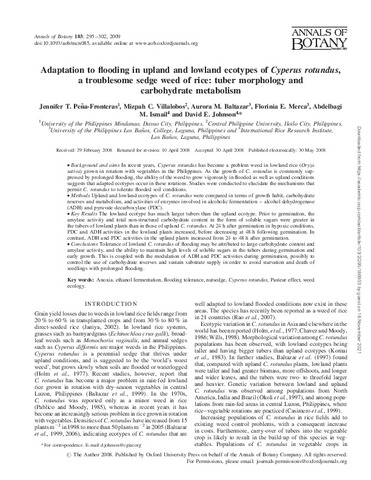Adaptation to flooding in upland and lowland ecotypes of Cyperus rotundus, a troublesome sedge weed of rice: Tuber morphology and carbohydrate metabolism

Associated URL
academic.oup.comPage views
512Petsa
2008-05-30May-akda
Magbahagi
Metadata
Ipakita ang buong tala ng item
Abstract
Background and aims
In recent years, Cyperus rotundus has become a problem weed in lowland rice (Oryza sativa) grown in rotation with vegetables in the Philippines. As the growth of C. rotundus is commonly suppressed by prolonged flooding, the ability of the weed to grow vigorously in flooded as well as upland conditions suggests that adapted ecotypes occur in these rotations. Studies were conducted to elucidate the mechanisms that permit C. rotundus to tolerate flooded soil conditions.
Methods
Upland and lowland ecotypes of C. rotundus were compared in terms of growth habit, carbohydrate reserves and metabolism, and activities of enzymes involved in alcoholic fermentation – alcohol dehydrogenase (ADH) and pyruvate decarboxylase (PDC).
Key Results
The lowland ecotype has much larger tubers than the upland ecotype. Prior to germination, the amylase activity and total non-structural carbohydrate content in the form of soluble sugars were greater in the tubers of lowland plants than in those of upland C. rotundus. At 24 h after germination in hypoxic conditions, PDC and ADH activities in the lowland plants increased, before decreasing at 48 h following germination. In contrast, ADH and PDC activities in the upland plants increased from 24 to 48 h after germination.
Conclusions
Tolerance of lowland C. rotundus of flooding may be attributed to large carbohydrate content and amylase activity, and the ability to maintain high levels of soluble sugars in the tubers during germination and early growth. This is coupled with the modulation of ADH and PDC activities during germination, possibly to control the use of carbohydrate reserves and sustain substrate supply in order to avoid starvation and death of seedlings with prolonged flooding.
Paglalarawan
Journal article
Mungkahing Sipi
Villalobos, M. C., Baltazar, A. M., Merca, F. E., Ismail, A. M., Johnson, D. E., & Peña-Fronteras, J. T. (2008). Adaptation to flooding in upland and lowland ecotypes of Cyperus rotundus, a troublesome sedge weed of rice: Tuber morphology and carbohydrate metabolism.Uri
ArticleISSN
1095-8290; 0305-7364Mga Paksa
Mga keyword
Collections
- Journal articles [12]
Mga parehong item
Ipinapakita ang mga item na nauugnay sa pamagat, may-akda, tagalikha at paksa.
-
Pyruvate decarboxylase activity of Cyperus rotundus L. under upland and lowland conditions
Villalobos, Mizpah C. (2006)Pyruvate decarboxylase (PDC) activity was measured from the roots of <em>Cyperus rotundus</em> seedlings obtained from upland and lowland ecosystems. PDC activity was detected in small amounts in the lowland plants but was ... -
A study on the improvement of the drainage system beside Central Philippine University, Iloilo City
Baldonado, Dene B. Jr. (1998)Sewerage system is important to the community for certain reasons. First, it is necessary for safeguarding the people’s health. If there is no proper drainage system, water will stagnate and the stagnant water becomes ... -
Survival of completely submerged rice plants
Palada, Manuel C. (1970)The survival of rice plant under completely submerged condition is influenced by the duration of submergence, water temperature, water turbidity, light intensity, water depth, stage of growth, variety and nitrogen level. The ...





